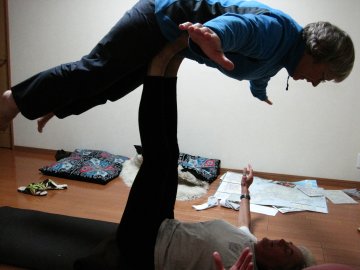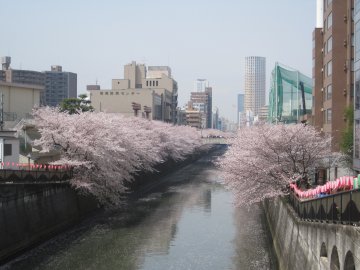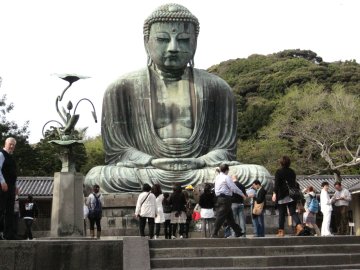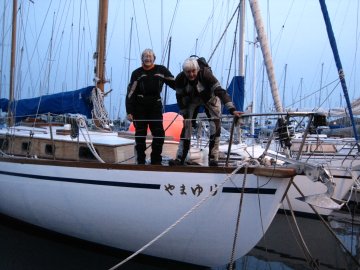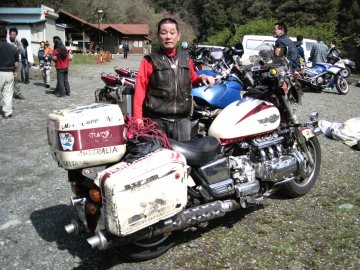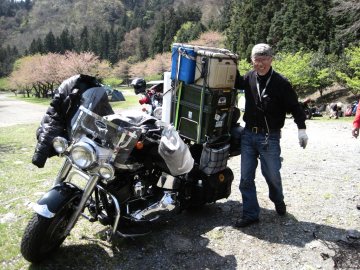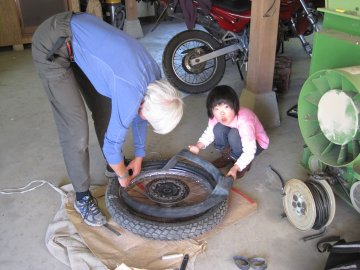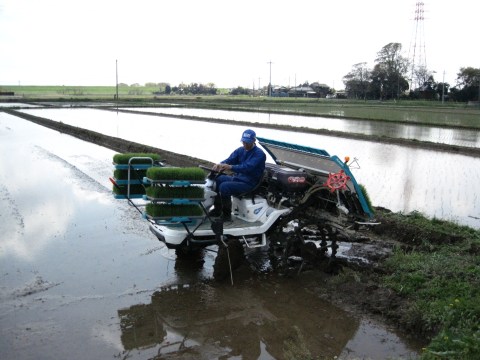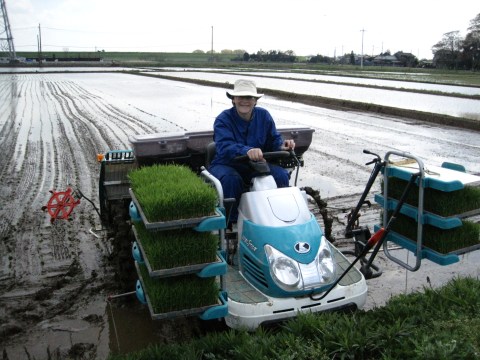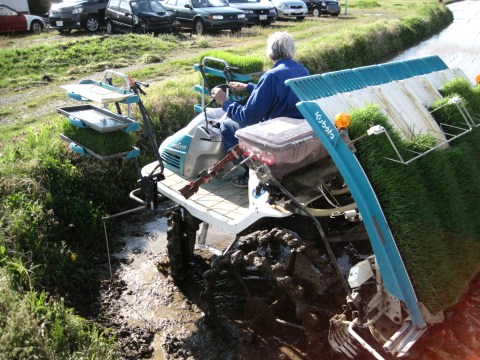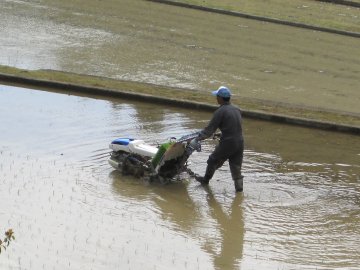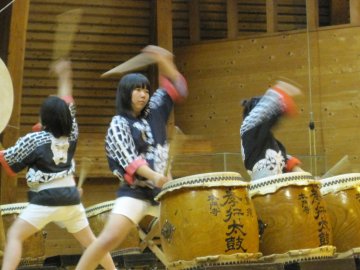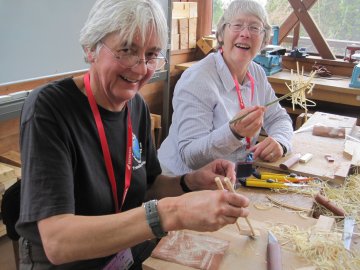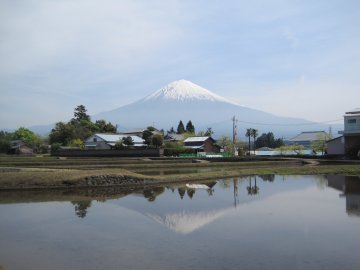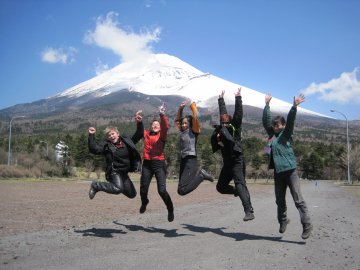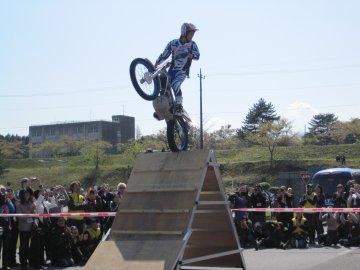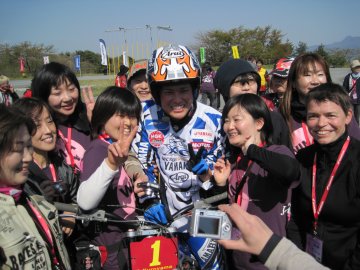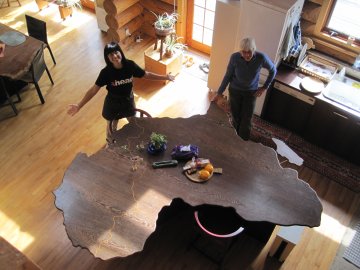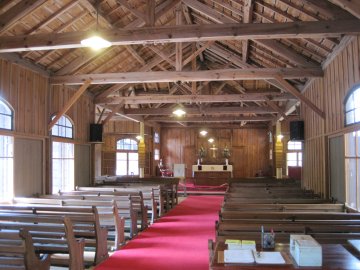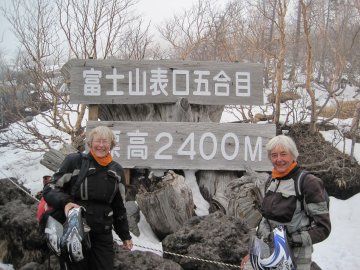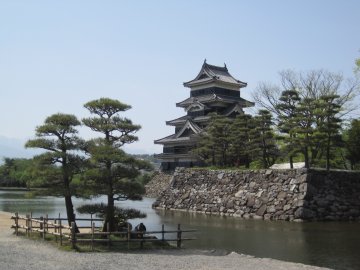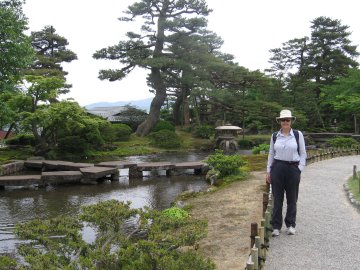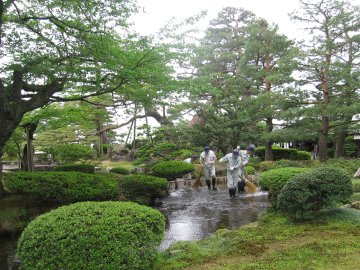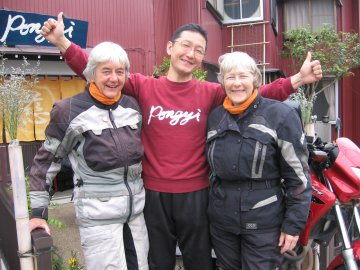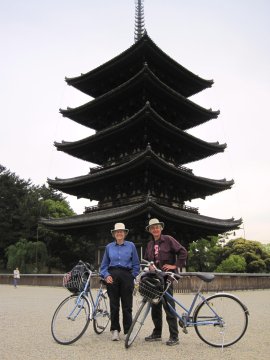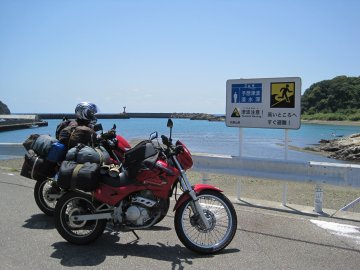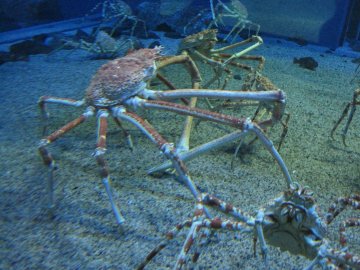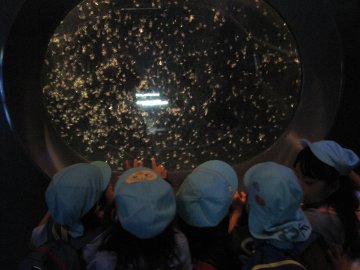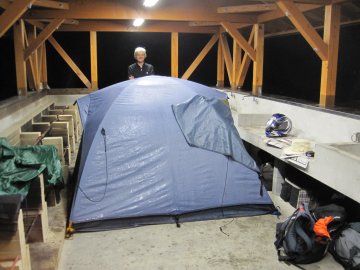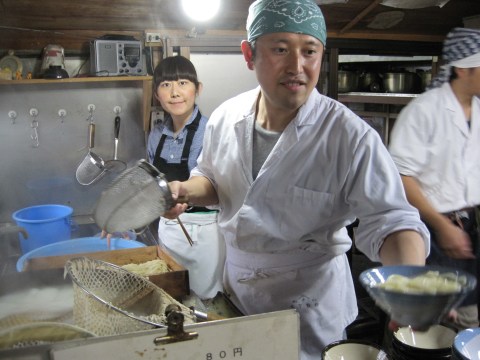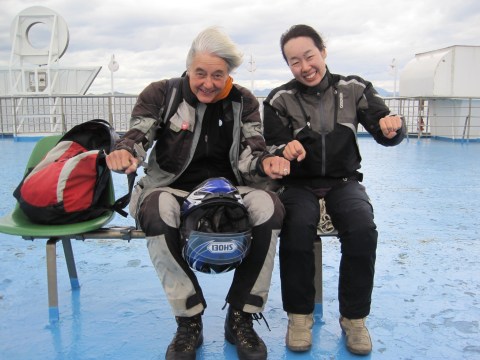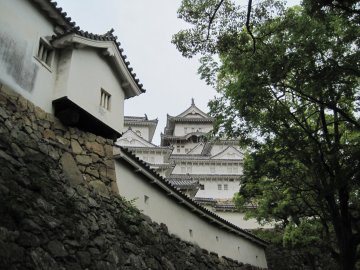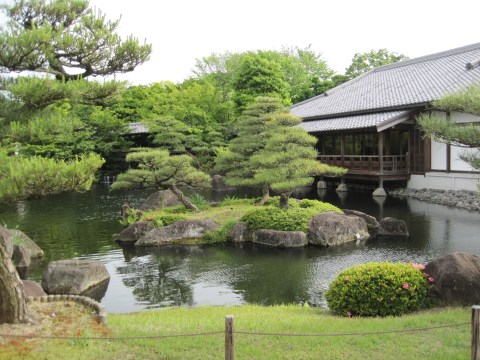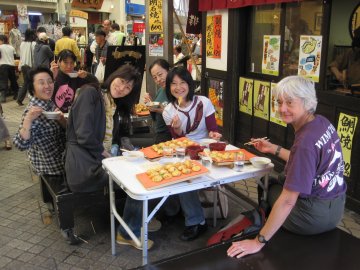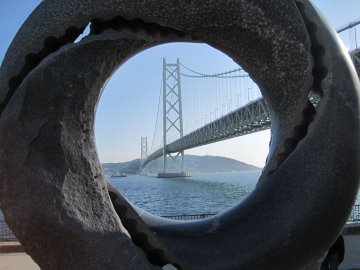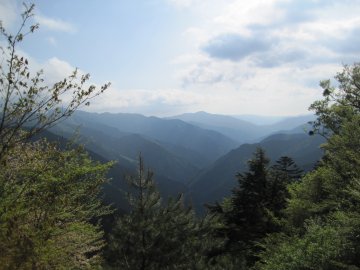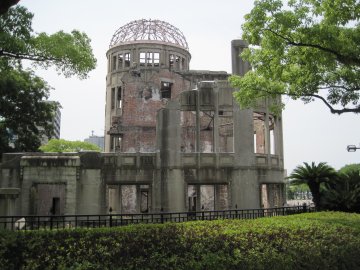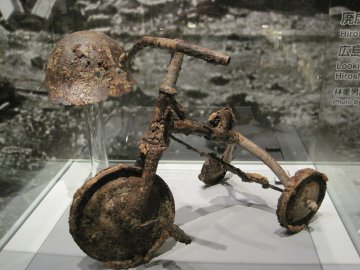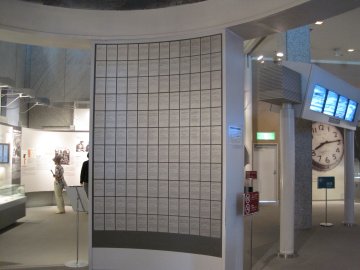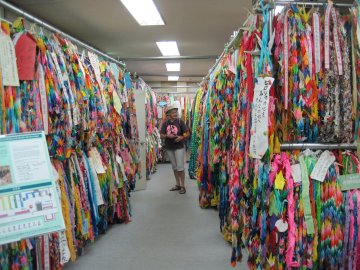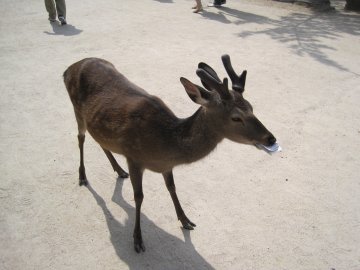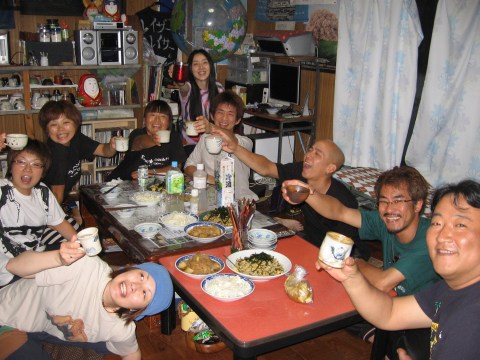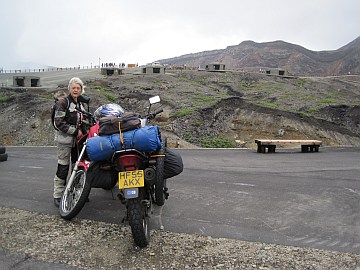Japan 5 April to 1 July 2010 (Part 2)
Base camp for the first three weeks was Tokyo with our great friend Yuko Sugeta who used to head up WIMA Japan (Womens International Motorcycle Association). She also used to test ride bikes for all the major manufacturers and edit LadiesBike Magazine. However now she runs her own acupuncture clinic and is mad about AcroYoga.
Yuko tells Pat to relax
Im about to fall off
We arrived at the height of the cherry blossom season.
Cherry blossom over the river in Meguro, Tokyo
Picnicking under the cherry trees is de rigeur at this time of year
We visited Kamakura with its giant Buddha and met a South African guy who gave us tea and biscuits on his boat and insisted we pose for pictures on the Emperor's yacht which was moored next to his in Enoshima harbour....
This Buddha has survived centuries of tsunamis and earthquakes, though it does look a bit battered on the inside
We werent at all sure the Emperor would approve
We went shopping but Pat said I couldnt have this kitten.
Nearly 136,000 yen thats over £1000.00
We got invited to the Japan World Touring Network weekend in April shortly after arriving.
Do contact Chris Lockwood the HU coordinator if you come to Japan to see if any meetings are planned you will be very welcome
It snowed that morning in Tokyo as we packed the tent..... and it was a cold ride. But we met a delighful crowd of guys and girls and were later able to tell a Japanese lady who was convinced that Japanese don't do overseas motorcycle travel about this guy who rode 280k round the world on his 1500cc Valkyrie.
Nice little touring bike
I asked him what happens when he drops his bike in Mongolia and he said I wait and wait and wait till somebody turns up to help me pick it up!
We think this was the guy who brought the beer for the weekend
Best of all we met Paco who is a Korean professional rice farmer living and working just north of Tokyo. A keen rider, he met his Japanese wife in Paraguay where he was working as a soil analyst and moved here to be with her and her family. His English is limited, and I speak next to no Japanese and no Korean so we communicate in Spanish! Paco is his Paraguyan name. We also met Heeyon, a Korean girl on a Serow who had ridden 55k miles round Australia tough lass next time we saw her, her leg was in plaster from an accident and she was still riding much to her doctor's disapproval and our admiration.
We rode up to Paco's a couple of weeks later on a cold and drizzly day and I got a puncture en route. Managed to pump up the tyre up and struggle on. Got lost and asked for directions in a small convenience store they kindly phoned Paco who came to find us. Next day, Pat mended the puncture, aided by Paco's 8-year old daughter. Our new tube was flat again the next morning but fortunately Paco had a spare that fitted so off came the wheel again and finally I was on the road again.
It takes much longer when children help....."
Then we had a totally amazing day as Paco let us loose with his rice-planting machine! He told me Pat was a natural and better than he was when he first started! He rents 40 fields (land is incredibly expensive one small field would cost 280,000 yen to buy) and works it all by himself.
Paco shows us how its done corners are tricky
so are the straight bits, not to mention stopping before you mount the bank
Pat of course has no problems with corners or straight bits
My field should produce 700kgs of rice and Pats field should produce 1000 kg (it was bigger!). They should both be ready to harvest on 20 August. Wish we could come back for that!
Since then Paco has been sending us pictures of our fields and reporting on their progress so far it all seems to be growing gratifyingly well. With that experience, we have been examining rice fields all over Japan with great interest. Pat has told me not to give you a dissertation on all the mechanics of rice growing in Japan, fascinating though it is! Some fields are so minute they have to be planted by hand, but we did see a lawn-mower sized machine in operation in one field. And they are all immaculate with edges shaved tidily or with beautiful stone walls in terraces.
Tiny rice-planting machine
Another highlight was the Women's International Motorcycle Association Rally (www.wimaworld.com) on the slopes of Mount Fuji at the end of April. About 130 foreigners and the same number of Japanese WIMA members made it through the cold and sleet to the site where cozy cottages awaited us. Japan WIMA put on a stunning rally an amazing first night of entertainment with a brilliant team of girl drummers from the local town, an illustrated talk from the first woman motorcyclist to successfully complete the Paris-Dakar rally and a stunning sushi and sashimi buffet. The first two days' activities were wiped out due to appalling weather so we amused ourselves relaxing, chatting and learning how to carve bamboo chopsticks, with professional tuition from the woodworkers on site.
They let us loose on their drums afterwards you really appreciate their skill and strength when you try it yourself its exhausting
The chopsticks work!
Finally on the third day the weather miraculously cleared up and there was Mt Fuji in all her glory. Fuji-san is one of those places you cannot believe will be as wonderful as it is cracked up to be. Well, it exceeds all expectations and is understandably revered all over Japan. Officially classed as a dormant volcano, Fuji stands alone at 3776 metres and towers over the surrounding plain which is itself ringed with mountains.
Five minutes after Pat spotted Mt Fuji in her wing mirrors as we rode away from the mountain
Yes I know this one is a bit cheesy.....
Rural Japan is so peaceful after the cities and the traffic
Pat says no more Fuji pictures..... Wima members jumping"
Entertainment included a private display by a top Japanese trials rider
he makes it look so easy
our hero is mobbed
And far too much to relate besides. It was a superb week and the Japanese WIMA team worked their socks off to provide a brilliant event one we will all remember for many years to come.
After the rally, Pat and I went and stayed a night at the Fairy-tale Cafe belonging to Reiko Yamamura, (the Paris-Dakar rider) and her partner Peta who is an organic farmer. They invited us to a fantastic dinner in their amazing wooden house complete with spiral staircase and lofty landing. The rustic cafe sports a loo so high tech that the lid opens as you walk towards it and closes as you walk away and naturally flushes all by itself all of which is a bit unnerving. Apparently Madonna has the same model in her London house.
Reiko and her African table her Dakar route is inlaid in the wood
We then headed north to Karuizawa where my grandparents met in 1912 and visited the church where they actually met. My grandfather was apparently very taken by my grandmother's gorgeous red hair.
I wonder which pews they were sitting in when they first laid eyes on each other
They got married in Tokyo in 1915. My mother's earliest memory, aged three, was feeling the tremors from the huge Tokyo earthquake in 1923, while the family was on holiday in Karuizawa. It was already a fashionable holiday destination back then, and is now crammed full of souvenir shops, but there are back streets where you can imagine how life was early in the twentieth century. The current Emperor of Japan also met his future wife in Karuizawa and broke with tradition by marrying a commoner of his choice rather than having an arranged marriage.
We stayed in the forest nearby with Chris Lockwood, the indefatigable HU Japan coordinator and his wife Masagi many thanks to both of you!
My grandparents were also members of the Japanese Alpine Club so it was fun riding over the Japanese Alps (albeit getting soaked in the process) thinking of them climbing in the same area. They also climbed Mt Fuji in the 1930's my excuse is we were here in the wrong season the official climbing season is only July and August. It also looks jolly steep and they were somewhat younger than me at the time! Excuses, excuses.
This is as far as we got and by bike at that
We stopped off at the stunning Matsumoto Castle
This is the oldest wooden castle in Japan
From Takayama we headed north to Kanazawa, planning to ride round the Noto Peninsula, but the weather was dreadful so we visited one of the top three gardens in Japan in a brief dry moment.
A rare moment with nobody else in the vicinity
The Japanese take their gardening extremely seriously. They are sweeping the stream.
We also chatted to the owner of the Pongyi hostel in Kanazawa. Masaki was a banker but left about five years ago, disenchanted with the world of commerce. He became a monk in Myanmar and gave all his money away to support children in Asia (we suspect his wife went about the same time), decided not to be a monk after all, but to open a hostel and eventually give all the profits to the same children's cause. So with the help of some friends, as he had no money, he rented an old kimono shop and the same friends helped him convert it and contributed furniture and fittings. The place is absolutely tiny and large untidy foreign backpackers or motorcyclists like us with huge piles of luggage fill it in an instant, but Masaki radiates peace and calm and gentleness and somehow all his guests respond in kind. Interestingly the minute loo was the only one we came across in Japan with a remote control, including flush button(!), helpfully labelled in English! Pongyi has only been open a year and is already outstandingly successful.
We never saw Masaki without a smile on his face
Heading south down the coast road towards Kyoto in torrential rain, we got our first glimpses of the jagged coastline that characterises so much of Japan. Minute fishing ports dot every inlet, but otherwise it seems completely undeveloped. Not a yacht marina in sight.
Midway between Kyoto and Nara we were kindly hosted by another motorcyclist Emiko and her family who welcomed the two of us, sodden to the core with soaking wet luggage, and provided a welcome base for sightseeing the Kyoto region.
A few of the 10,000 tori leading to the Fushimi-Inari shrine just outside Kyoto
Emiko and daughter Chisato. I have become incapable of posing without holding my fingers up Japanese style
On our way south to Nara we stopped off at Uji, one of the oldest cities in Japan and setting for the final chapters of The Tale of Genji. This was written in the eleventh century and is claimed to be the oldest novel in the world. It is also the site of the Byodo-in Temple, also eleventh century. The book has survived better than the temple, which has been repeatedly rebuilt after devastating fires. Today's onslaught was from about 500 Japanese school-children on a day's outing.
Byodo-in Temple the schoolchildren were out of sight for about 10 seconds
We loved Nara. It is smaller and more manageable than Kyoto but has some amazing temples, and hordes of small, friendly deer wandering all over the place. The Youth Hostel had some excellent bicycles so we cycled everywhere.
So nice to be out of our riding gear for a change
This is the 5-storied pagoda of Kofukuji Temple, and a World Heritage Site. Originally built in 725 and last rebuilt in 1426, it is the second highest pagoda in Japan at over 50 meters high.
Suddenly the weather was gorgeous so we did a couple of days riding along spectacular mountain roads down to the bottom of the peninsula.
A rather sobering tsunami warning on the Nara peninsula coast
Then up to Osaka, which we predictably hit in the rush hour in the dark to stay with our friend Mime who once won a slow-riding competition at a WIMA rally by standing on the pegs and just hovering till everybody got bored said ok ok you win. We arrived on Pat's birthday and Mime produced a cake!!
We'd had enough of culture by now so went to the Osaka acquarium, which concentrates on the sea-life around the Pacific Ring of Fire. Among the displays is a massive 9-metre tank you walk down and through, protected by extremely thick glass. It houses a large whale shark, massive rays and a host of other sealife. The primary school children were here en masse today we hoped for the sake of the tank inhabitants that the glass between us and them was soundproof.
These giant crabs live at a depth of 200-400 metres on the slopes of the trench near Japan
they were screaming their heads off with excitement
And of course we ate okonomiaki which is famous in Osaka, not to mention Tokyo and Hiroshima so we had to sample all three types).
Mime and Michiko tackle the okonomiaki with enthusiasm
We then rode north again, sampled the hot springs at Kinosaki and had an idyllic night's camping by the beach. Continuing west along the coast to the famous sand dunes of Tottori, Pat's gear lever started slipping, so progress became rather slow as she had to keep inserting bits of beer can between the splines of the lever and the shaft on the bike.
The rain was relentless from the first night, so we spent the whole of the next day in the tent, reading and chatting in English at one point to a pack of small girls belonging to the Tottori Girl Guides who'd come for an outdoor cooking lesson. You can imagine the conversation repeated 20 times.... what is your name? with each beaming child!
We moved into the camp kitchen on the second night, hoping the tent would dry out so we could pack it next day and move on .
It was still throwing it down on the morning of the third day, so we moved into the nearby hostel, as the thought of constantly fixing Pat's gear by the side of the road in the rain was not appealing. The weather forecast for the next 3 days was also dreadful. Thirty minutes later, after we'd paid, it stopped raining and the sun shone for the next few days ...
Next stop in a lovely rural setting was with Chie and her family who run the Triumph dealership in Okayama and a large showroom full of other bikes and gear in Tsuyama. Chie has recently joined the family firm after several years in computers in Tokyo and is developing the rental and tours business. They already run yearly tours for the Alaska Riders tour company, whom we bumped into in Patagonia in 2006.
Next morning we're out early down to Okayama to meet a TV crew from Shikoku Island who interview us and follow us over the stunning (and stunningly expensive fortunately we were handed credit cards to pay the toll) Seto Hashi bridge to eat Udon noodles at the most famous udon shop on the island. We are commanded to slurp our enjoyment noisily (camera in face all the while) and express our opinion. Have to admit they were the best Udon we have ever tasted. Then a madcap dash to the ferry and home in time for the 6 o'clock news to watch ourselves making fools of ourselves.
Yummy udon
The ferry ride back was a bit windy
Chie's father whipped off Pat's gear lever and replaced it with one he scavenged off a XR250 he had lying around. He also noticed that my clutch cable was hanging on by three threads (I hadn't!), so replaced it with one off a new Chinese bike in his workshop and refused to take payment for either which was very kind of him. And Chies mother took us off to visit the interesting town of Kurashiki and taught me lots of Japanese they really looked after us!
The bikes washed and suitably fettled, we rode eastwards to the World Heritage Site of Himeji Castle. 400 years old and one of the few not destroyed by fire, war or earthquake, it is rated as the most beautiful castle in Japan.
Himeji Castle. Unfortunately they're doing major repairs so we couldn't go inside the central fortress
An unexpected bonus was the adjacent set of nine stunning gardens built quite recently on the site of some old samurai houses. They were by far the best gardens we saw in Japan.
Japanese tea ceremony inside on the right
Then into Kobe to stay with Michiko and Tei, who live almost underneath the fine bridge to Awaji Island. Michiko is Professor of Jewelry Design at Kobe University and is President of WIMA Japan. She organised a party for us of a number of old friends we had not seen for years which was brilliant. She also taught Pat (who is learning silversmithing) how to colour titanium.
Octopus ball party in Kobe another speciality
When the big earthquake struck Kobe in 1995, only two glasses got broken in Michiko and Teis house. However they were reduced to fetching seawater in a bucket for a month to flush the loo. They got away lightly over 6500 people died and 300,000 were made homeless.
The Akashi Bridge to Awaji Island stretched but did not break in the earthquake
From Kobe we took the ferry to Awaji Island and then onto Shikoku Island which is very mountainous, and boasts 88 temples on a pilgrimage route we saw many pilgrims walking the route wearing traditional conical hats. It was here we stayed for three weeks and had a blissful rest from being tourists and rushing from pillar to post. And I had a great birthday party thanks very much Viennessa!
Michiko and Tei drove down from Kobe to join us, which was brilliant
The views on our rides with our local expert Tomoka were amazing
We did a quick side trip to Hiroshima for another WIMA party and stayed with Hiroe and her husband who is a fanatical classic car lover with two old Lotuses in his front garden and an F2 car in a box of bits hidden away. They share a Ducati. Many thanks for your hospitality and also to Yuki for doing all the translating! And Yoko for the great wine! Not to mention Tomoka for driving us up there and Viennessa for lending us the car!!!
Hiroshima was amazing. There is a huge peace park and a stunning museum, which we spent hours in.
The museum presents a very balanced picture of the historical build up of Japanese military force from the Meiji period in the latter part of the 19th century right through to World War II. It also has heart-rending displays of shredded clothing and personal effects of schoolchildren. Young teenagers and women were detailed on demolition work so were caught outside when the bombs were dropped. Hiroshima and Nagasaki were extremely important military factory sites and naval ports. They were spared the carpet-bombing of most other cities in Japan as the US government wanted to see the effect of a nuclear bomb. In addition to strategic reasons, the US government also had to justify to its voters the $2 billion spent on research. The Japanese had refused to surrender despite losing the Pacific war, so the Hiroshima bomb was dropped with no warning on 6 August 1945. (Pat points out that if it had not gone off, the Russians would have known the nuclear threat was not credible, hence no warning). The Nagasaki bomb followed 3 days later, as much a warning to the Russians to stay out of the area as to convince the Japanese government that further resistance was hopeless. Millions of stunned Japanese then heard their Emperor on the radio for the first time (remember, he was divine), say in a masterpiece of understatement The war has developed, not necessarily to Japan's advantage and the war was over.
Hiroshima and Nagasaki have both reinvented themselves as cities for peace and there is a large section devoted to the peace movements during the Cold War, including Greenham Common in the UK. I swear the photo of the women surrounding the US Cruise Missile base there around 1983 includes my cousin Gilly in the corner. I must be just out of sight, hiding from the cameras as my boss had threatened me with the sack if any of our clients spotted me on tv or in a newspaper....
The ruins of the Hiroshima Prefecture
Just one of the many poignant symbols of the destruction
Copies of protest letters sent by Hiroshima mayors each time a nuclear test is carried out. Bottom right is to North Korea in May 2009 letter number 594
A few of the millions of origami cranes made by people all over the world as peace symbols
A total contrast lay just an hour away. Miyajima Island and its beautiful shrines have been a sacred site for over a thousand years.
The huge tori or gate. Its position in the sea indicates the whole island is sacred
Deer are considered messengers of the gods. They are extremely fond of tourist brochures and train tickets
We finally tore ourselves away from Shikoku Island and headed for Kyushu Island as time was now getting short. After a frustrating time in Beppu, unsuccessfully trying to book our ferry to Korea, we moved on to Aso in the centre of the island and holed up in the tiniest hostel yet.
It's a Riders House, designed especially for motorcyclists so the bikes all had plenty of space undercover. We were squashed in a tiny dorm with four girls who just had room to lay their mats on the floor (all our luggage was outside on the balcony) and we were in the bunk beds, from which two of the girls had been ejected for our benefit. We bought chocolate biscuits to compensate.
It poured down for two days. so everybody was confined indoors in a minute living room with a huge tv, where we first watched the Korean soaps that are all the rage across Asia. The Japanese are so considerate of personal space and each other, that it was a unique experience for us, and astonishingly good fun. Some of them were very young and were riding for months around Japan on their own on very small bikes so they had lots in common. While we were out sploshing around on bicycles and treating ourselves to another onsen (Riders House is too small for a shower room), they built a sofa out of bamboo poles and rope so we were all rewarded with a free meal by the hostel owner! It was great for us as it kills our knees sitting on the floor at low tables, very common in Japan.
Campai! One of many toasts in Aso Riders House
Our patience was finally rewarded and the day we left we managed to ride up Mount Aso itself to see the centre of this still live volcano. The crater left by the last massive explosion is one of the largest in the world and must have been devastating. Several towns and villages and miles of farmland now fill the space.
The clouds and sulphurous steam parted just long enough for us to peer into the heart of Mt Aso
Note the evacuation shelters in case of a sudden eruption at Aso
Nagasaki is a beautiful coastal city stretching for miles up a steep wooded valley with an attractive river running through the centre. It was on the short list of four cities designated for a potential atomic bomb drop, along with Hiroshima and got chosen only at the last minute as the weather suddenly cleared here that morning. There are memorials all over the Peace Park and an impressive Peace Museum. The historical approach is again balanced and there are many fascinating video and audio interviews with Korean and Australian victims. Somewhere between 10-20,000 Koreans who'd been brought over as forced labour to the munitions factories, and about 200 Australians as there was a POW camp nearby, were affected by the bomb.
The four-hour downpour that accompanied us the day we left for Shimonoseki gave us the opportunity of testing the new waterproofs we'd bought in Osaka. I'm delighted to report we can now ride in the rain with impunity, subject to having time to get them on before getting soaked.
Getting tickets for the ferry to Korea is quite complicated as all the ferry companies insist you buy a return, which is double the single price. You cannot therefore book online and nobody speaks English on the phone. Two of our local friends had also tried to ring and explain our situation, to no avail. So I was delighted to find through the HU forum site that Nippon Travel Agency in Kobe had managed to get single tickets for some other travellers. A couple of emails and phone calls later and we were sorted. Phew! Not many travellers on bikes come this way and we were personally escorted by the Kampu Ferry Business Manager, who speaks English, to customs to export our bikes and then again onto the ship. He was very worried about Korean customs letting us in so insisted on faxing all our documents to them!
We could hardly believe our three months in Japan was over. We had a brilliant time, saw huge amounts of this wonderful country. Japan has just had the worst spring and summer in decades which was a shame, so we have few great landscape photos. But the good days were glorious. We experienced amazing hospitality and the food was wonderful. I now speak survival Japanese and Pat is a dab hand at reading maps in Kanji whilst riding along! We have caught up with so many old friends and made so many new ones we have to return one of these days to see you all and get to those bits of Japan we missed. Thank you all!


